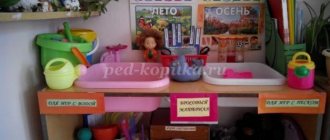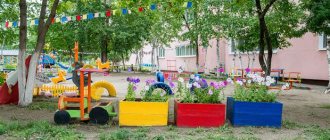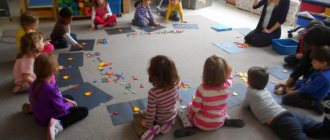Article “Organization of the subject-spatial environment in the second junior group.”
Organization of subject-spatial environment
in the second junior group.
The developing subject-spatial environment of the second junior group is organized taking into account the Federal State Educational Standard for Educational Education, taking into account the opportunities for children to play and study in separate subgroups, individually, as well as taking into account the integration of educational areas. The subject-spatial environment is aimed at developing the child’s independence and initiative, but provides for the leading role of play activities.
The subject-development environment begins from the reception area, where we meet our kids. There are individual lockers, bright colored benches, and an “algorithm” for the dressing process. Bright pictures are glued to the cabinets and the names of the children are written. In the reception area, various information corners for parents have found their place: “Aibolit’s Advice”, “For You, Parents”, “Our Teremok Group”, “Quotes from Great People”, “Congratulations”, as well as an exhibition board for crafts and drawings guys "Talented Fingers". The stands provide recommendations for parents on organizing children's leisure time, materials for games and home activities. Mini-library of methodological literature for parents, books for children to read at home, kindergarten and group operating hours, announcements.
When creating a subject development environment for the 2nd junior group, gender specifics are taken into account. The environment is provided with both general and specific material for girls and boys. In the group room there are educational and didactic games, books selected taking into account gender differences, attractive in content for girls, and similarly for boys. Girls prefer to spend time in the centers of role-playing games, dress-up corners, “kitchen”, “hair salon”; boys are in the center of technical toys, in the center of construction games, on carpets with cars, in motor activity centers.
In order for each child to be able to find something to do and do something they like, the group has created conditions for different types of activities (play, productive, communicative, creative and cognitive-research, etc.).
Game center.
Playground equipment creates an optimally rich, holistic, multifunctional environment with ample space for play.
The game center for role-playing games helps to form the foundations of a culture of communication in children through solving problem situations and consolidates knowledge about the surrounding reality and life in society. Selected game material allows you to combine different plots and create new game images. All toys and play material are placed in such a way that children can play freely and put everything away in its place. For this purpose there are racks, cabinets, drawers. Our play center contains toys that introduce children to the everyday objects around them. Our developmental environment suits the interests of boys and girls. For girls, the kitchen is of greater interest, where you can prepare a delicious lunch; a mini-hair salon, where you can try to give your doll or friend a fashionable hairstyle, as well as a “Medical office”, where they take their dolls for treatment. How boys want to grow up quickly and get behind the wheel!.. Therefore, our corner with big cars and steering wheels is primarily of interest to boys.
It is equipped with the necessary attributes for road role-playing games and activities to consolidate knowledge of traffic rules.
In the center are:
- dolls, baby dolls
- soft sofa for children, armchairs, table
- a set of bed linen
- underwear for dolls by season
- baby strollers for dolls
- rack for toys “Houses”
- plastic toys (animals, beasts)
- pyramids: large, medium, small
- children's phone
- children's plastic irons
- ironing board
- toys - plastisol (domestic and wild animals, etc.)
- cars - models
- transport (plane, boat, motorcycle, helicopter, bus, etc.)
- "Aibolit" set
- set for boys "Tools"
- binoculars
- kitchen with elements of upholstered play furniture
- teaware, tableware, kitchenware
- children's kitchen table
- plastisol (rubber fruits, vegetables, berries, products)
- children's kitchen tray, cutting board
- mummers corner
- game mirror
- children's plastic hangers
- "Young hairdresser" set
- aprons, robes, scarves, ribbons.
- hairdressing accessories - substitutes.
Design Center.
The contents of the construction center allow you to organize constructive activities with a group of children, a subgroup and individually, to develop construction on the carpet or on the table. Also here, on spacious shelves, there are cars - dump trucks, trucks, cars (children can easily roll soft toys in them, or simply transport construction sets). To maintain children's constant interest in gaming material, we place it in various places in the group room next to the toys. The free space on the floor makes it possible to build buildings. There are also figures of animals, which provides an opportunity for greater development of imagination and creative thinking.
In the center are located:
1.Large building designer.
2. Average building designer.
3. A set of small building material with basic parts.
4.Lego-type construction sets.
5. Small toys for playing with buildings (figurines of people and animals, etc.).
6. Medium and large toy vehicles. Trucks, cars, a fire truck, an ambulance, a steam locomotive and trailers, a boat, an airplane.
7. “Fortress” constructor
Motor activity center.
Taking into account the need for movement in children is an important task when organizing a subject-development environment. One of the most favorite corners in the group is the Physical Activity Center. It fits succinctly and harmoniously into the space of the group room. It is popular among children because it fulfills their needs for physical activity.
Here are:
- skittles, ring throws
- rattles
- ball baskets
- height measuring tape “We have grown up”
- massage mats, health paths, clubfoot path
- tunnel
- balls (small, large, medium, soft)
- flags, handkerchiefs, rattles, ribbons, ribbons on rings
- jump ropes
- hoops
- winders
- dumbbells for children
- Darts game
- basketball net.
- non-standard author's physical equipment
- didactic material, card indexes, as well as manuals necessary for morning exercises and awakening exercises.
We recently purchased. helps the teacher in organizing amateur games - experimenting with various objects and natural materials. By organizing games with sand and water, we introduce children to the properties of various objects and materials, reinforce basic ideas about the shape, size, properties of objects and materials, and develop the child’s fine motor skills. A child’s games with sand and water not only captivate children, but also provide an opportunity to better learn about the inanimate world around them. Exercises on the surface of water and sand associated with tactile-kinesthetic sensitivity relieve emotional stress.
the most important object of the subject-development environment, since it is theatrical activities that help to adapt faster, unite the group, and unite children with an interesting idea, a new activity for them. Education takes place not on behalf of an adult, as yet unknown person, but from dolls. An adult can correct or make a remark, addressing not the child, but the doll, and such an influence from the teacher will be much softer and more correct.
In the center are located:
1. small screen for tabletop and puppet theaters
2. large screen
3. theaters: puppet theater, tabletop theater, flannel theatre, shadow theater, wooden theater (based on fairy tales), bi-ba-bo.
4. Costumes, masks, attributes for acting out fairy tales.
.5. Set of masks of fairy-tale animals.
At the center of the music are:
Sounding instruments:
rattles; diamonds; pipe; drum; xylophone; wooden spoons; knockers; guitar; record player.
Plastic containers with different fillings: peas, acorns, pebbles.
There are musical instruments here that bring children many joyful moments, and, in addition, develop phonemic hearing and a sense of rhythm in the baby. There is also a piano, tape recorder, audio CDs with fairy tales and music. We try to introduce children to various types of theater. Here we have a flannelgraph, a table theater, a finger theater and a shadow theater.
Meeting a doll helps children relax, relieve tension, and create a joyful atmosphere.
Early age is most favorable for the development of visual activity. The brightest place in the group is reserved for the center. The child can pull out the table and sit near the window to draw. Drawing for a child, along with play activities, is of great importance because visual activity is an integral part of the process of learning about the world around us. Here, in their free time, students draw, sculpt, and do appliqué work. In the center are:
- art table
- colored pencils
- wax crayons
- gouache
- felt-tip pens
- tassels
- coloring pages
- plasticine
- boards for working with plasticine
- stencils
- drawing paper
There are also plot pictures, books according to the program, children’s favorite books; albums for viewing: “Professions”, “Wild Animals”, “Seasons”; sets of subject and subject pictures.
.
The Book Corner will help us read a fairy tale or look at our favorite illustration in a book.
Thematic selection of children's fiction:
- hardcover books.
- books - babies
- books for adults to read to children: Nursery rhymes, jokes
- poems for children by A. Barto; M. I. Marshak and other authors
- short Russian folk tales
- illustrated magazines about fairy-tale characters and animals.
- reading book with illustrations “Polite words”
- book for reading from 2 to 4 years.
Cognition Center.
a math corner on the large colored “Locomotive” rack
with handouts, geometric figures, as well as entertaining and educational mathematical material, logical and mathematical games; with a sensorimotor development corner, which is designed to develop fine motor skills and tactile sensations. Here children learn to tie shoelaces, string large beads, assemble mosaics, etc.
didactic games in mathematics:
1. Large mosaic, volumetric inserts of 5-10 elements, prefabricated toys, pyramids (of 6-10 elements), lacing, games with modeling and substitution elements, lotto, paired lotto pictures, color, shape, quantity, size, part and whole, time of day and other board and printed games.
2.Wooden figures with strings for stringing.
3. Carpet fabric, typesetting fabric, magnetic board.
4. A set of geometric figures, objects of various geometric shapes, counting material with Velcro, a didactic cube “A house for each figure.”
5.Various small figures and material for counting.
6. Logical-mathematical games: “Columbus Egg”, “Tangram”, “Denesha” Blocks
7. Matryoshka dolls, insert boards, insert frames, a set of counting sticks.
8. A set of volumetric bodies for series by size from 3-5 elements (cylinders, bars, etc.).
9. Cut pictures with subject pictures (4-6 parts).
10. Soft puzzles, maxi
Speech development corner
represented by plot and subject pictures, card files of speech games, classification games, didactic games, books.
materials on speech development and cognitive activity:
1. Sets of pictures for grouping, up to 4-6 in each group: pets, wild animals, animals with young, birds, fish, trees, flowers, vegetables, fruits, food, clothing, dishes, furniture, transport, household items .
2. Sets of subject pictures for sequential grouping according to various characteristics (purpose, etc.).
3. A series of 3-4 pictures to establish the sequence of events (fairy tales, social situations).
4. Series of 4 pictures: parts of the day (activities of people in the immediate environment).
5. Series of 4 pictures: seasons (nature and seasonal activities of people).
6. Large format plot pictures (with various themes, close to the child, fairy tales, social everyday life).
7.Toys and exercise equipment for training proper physiological breathing.
In the traffic rules corner
There are various
materials on traffic rules and life safety:
1. Layout showing the road, pedestrian crossings.
2. Various types of transport.
3. Models of houses, trees, traffic lights, road signs.
4.Small toys (figurines of people, animals).
5. Board and didactic games on traffic rules and life safety: “Dangerous situations”
6. Demonstration pictures;
and "Experimentation".
The center has created conditions for enriching children's ideas about the diversity of the natural world, nurturing a love for nature and a careful attitude towards it. As well as introducing children to caring for plants, forming the beginnings of an ecological culture. It also combines a center for experimentation with natural materials, bulk materials, containers of different capacities, a nature calendar, and indoor plants. Books and booklets about the seasons (poems, illustrations) are also presented here. In the center are indoor plants with large leathery leaves and a typical erect stem - Ficus. Plants are presented in 2 types so that children can learn to find identical plants. Ficus is a good air purifier, evergreen begonia fights diseases of the upper respiratory tract, balsam, coleus, hybrid fuchsia.
The center includes environmental games:
lotto, collect a flower, parts of a tree, feed the animals, find your mother;
musical posters “wild, domestic animals”, cut-out pictures, block inserts.
Nature calendar
, which depicts a painting depicting the seasons; story pictures and photographs depicting children's activities at different times of the year; cards with birds, plot pictures “Seasons”. Before going out for a walk, we dress the didactic doll according to the season and place it with a nature calendar.
Aquarium with large fish.
To develop children's interest in research activities, ideas about the surrounding nature and in order to develop their intelligence, an experimentation corner has been created.
In the process of conducting simple experiments, children turn into inquisitive explorers. Together with the children, we determine the properties of water. Children love to play with water - it gives them positive emotions.
In the corner there are watering cans, sticks for loosening the soil, a sprayer, rags, and aprons. Natural materials: sand, water, clay, pebbles, shells, pieces of wood, various fruits, seeds, cereals. Containers of various capacities, spoons, spatulas, funnels, sieve, rubber and plastic toys for playing with water. Mirror for playing with a sun bunny. Magnifying glasses, “magic” glasses – colored “glasses” (made of plastic). demonstration material of different types: iron, wood, plastic, glass; demonstration material “Types of fabrics”.
PRIVACY CORNER
If a child is tired of noise and wants to be in silence, he can go to a corner of solitude and relaxation. To do this, the sofa is fenced off from everyone else with a screen. Nearby there is a table on which there is a mobile phone (for children), so that the child can call mom and dad - all this has a beneficial effect on the emotional state of children.
Thus, the variety and richness of sensory impressions makes it possible to freely approach each center in the group and contributes to the emotional and intellectual development of students. Our developmental environment evokes in children a feeling of joy, an emotionally positive attitude, enriches them with new knowledge and impressions, and encourages active creative activity.
In our group, we try to create a comfortable subject-spatial environment that corresponds to the age, gender, and individual characteristics of children.
What should be in a math corner?
Occupancy of the math corner
:
In the math corner
There is a carpet, a board for working with chalk, a magnetic board, a cash register for numbers, and sets of cards.
Interesting materials:
How to apply degreaser to nails? How to write without content? How to write an email to the tax office? How to write a private message on Twitter? How to write a private message in Valorant? How to write an explanation to school about a pass? How to write an explanatory note to the tax office? How to write an application to the tax office via the Internet? How to write an appeal to the tax office? How to write a review on Violity?


